instrument panel Peugeot 308 2017 Owner's Manual - RHD (UK, Australia)
[x] Cancel search | Manufacturer: PEUGEOT, Model Year: 2017, Model line: 308, Model: Peugeot 308 2017Pages: 392, PDF Size: 10.13 MB
Page 4 of 392
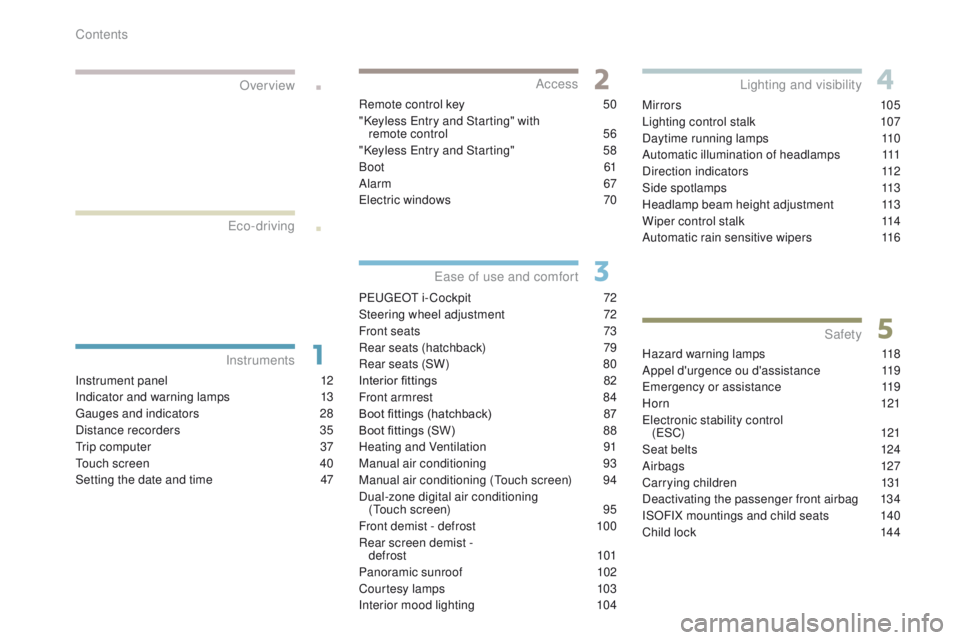
.
.
Over view
Instrument panel 12
Indicator and warning lamps
1
3
ga
uges and indicators
2
8
Distance recorders
3
5
tr
ip computer
3
7
to
uch screen
4
0
Setting the date and time
4
7Remote control key
5
0
"Keyless e
n
try and Starting" with
remote control
5
6
"Keyless e
n
try and Starting"
5
8
Boot
61
Alarm
6
7
el
ectric windows
7
0
P
e
uge
Ot
i- Cockpit
7
2
Steering wheel adjustment
7
2
Front seats
7
3
Rear seats (hatchback)
7
9
Rear seats (SW)
8
0
Interior fittings 8 2
Front armrest
8
4
Boot fittings (hatchback)
87
B
oot fittings (SW)
8
8
Heating and Ventilation
9
1
Manual air conditioning
9
3
Manual air conditioning (
to
uch screen)
9
4
Dual-zone digital air conditioning (
to
uch screen)
9
5
Front demist - defrost
1
00
Rear screen demist - defrost
101
Panoramic sunroof
1
02
Courtesy lamps
1
03
Interior mood lighting
1
04Mirrors
105
Lighting control stalk
1
07
Daytime running lamps
1
10
Automatic illumination of headlamps
1
11
Direction indicators
1
12
Side spotlamps
1
13
Headlamp beam height adjustment
1
13
Wiper control stalk
1
14
Automatic rain sensitive wipers
1
16
Hazard warning lamps
1
18
Appel d'urgence ou d'assistance 1 19em
ergency or assistance 1 19
H or n
121
ele
ctronic stability control
(
e
SC) 121
Seat belts
1
24
Airbags
127
Carrying children
1
31
Deactivating the passenger front airbag
1
34
ISOFIX mountings and child seats
1
40
Child lock
1
44
eco-driving
In struments Access
ea
se of use and comfort Lighting and visibility
Safety
Contents
Page 10 of 392
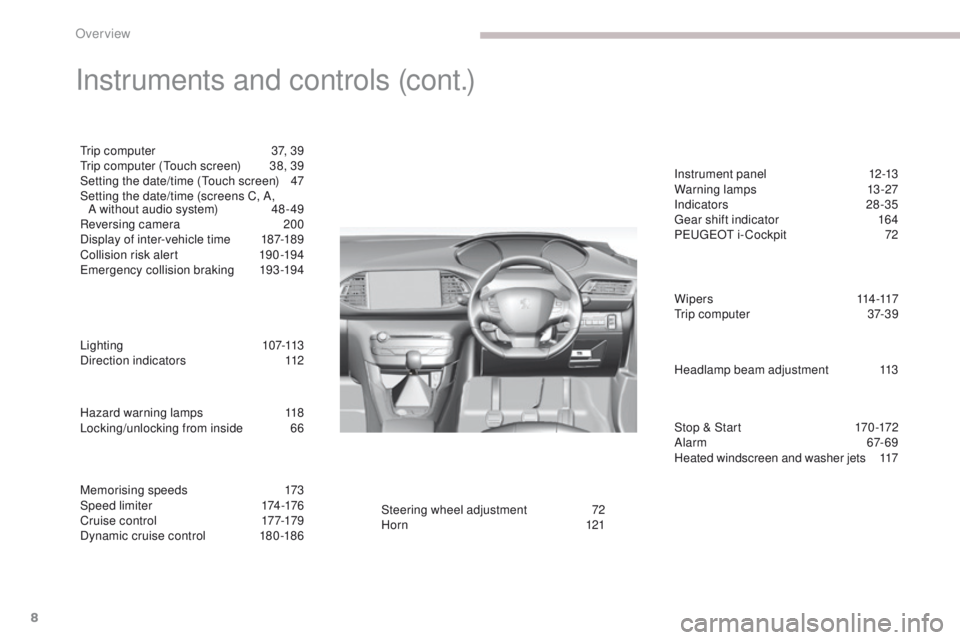
8
Hazard warning lamps 118
Locking/unlocking from inside 6 6
Lighting
1
07-113
Direction indicators
1
12 Instrument panel
1
2-13
Warning lamps
1
3-27
Indicators
28-35
ge
ar shift indicator
1
64
P
e
uge
Ot
i- Cockpit
7
2
Steering wheel adjustment
7
2
H or n
12
1
Memorising speeds
1
73
Speed limiter
1
74-176
C r u i s e c o nt r o l
17
7-179
Dynamic cruise control
1
80 -186 W i p e r s
11
4 -117
tr
ip computer
3
7-39
Instruments and controls (cont.)
trip computer
3 7, 39tr
ip computer (to uch screen) 3 8, 39
Setting the date/time (
to
uch screen)
4
7
Setting the date/time (screens C, A, A
without audio system)
4
8 - 49
Reversing camera
2
00
Display of inter-vehicle time
1
87-189
Collision risk alert
1
90 -194
em
ergency collision braking
1
93-194
Stop & Start
1
70 -172
Alarm
6
7-69
Heated windscreen and washer jets
1
17
Headlamp beam adjustment
1
13
Over view
Page 12 of 392
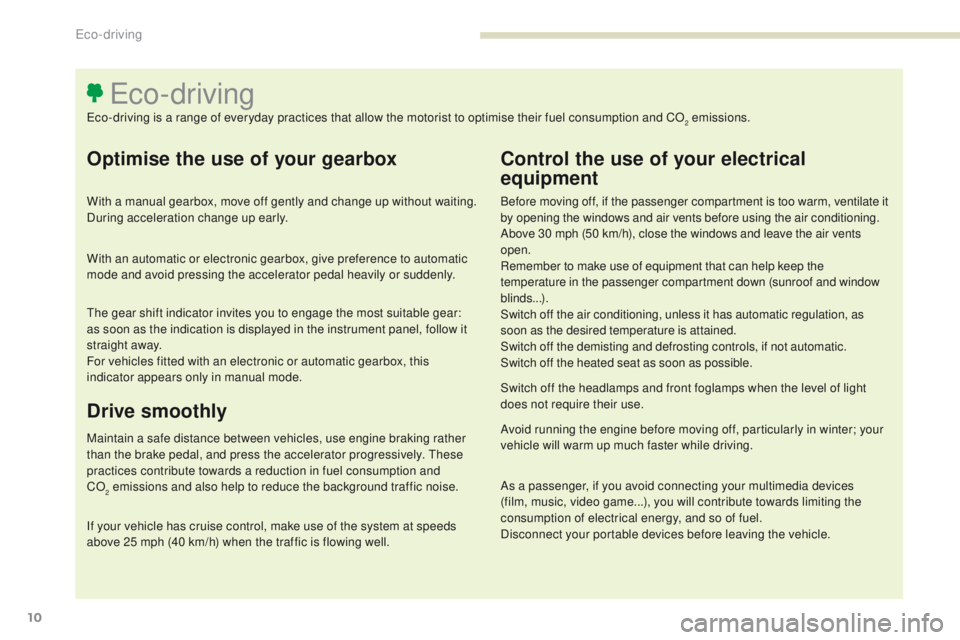
10
Optimise the use of your gearbox
With a manual gearbox, move off gently and change up without waiting.
During acceleration change up early.
With an automatic or electronic gearbox, give preference to automatic
mode and avoid pressing the accelerator pedal heavily or suddenly.
Control the use of your electrical
equipment
Before moving off, if the passenger compartment is too warm, ventilate it
by opening the windows and air vents before using the air conditioning.
Above 30 mph (50 km/h), close the windows and leave the air vents
open.
Remember to make use of equipment that can help keep the
temperature in the passenger compartment down (sunroof and window
blinds...).
Switch off the air conditioning, unless it has automatic regulation, as
soon as the desired temperature is attained.
Switch off the demisting and defrosting controls, if not automatic.
Switch off the heated seat as soon as possible.
Switch off the headlamps and front foglamps when the level of light
does not require their use.
Avoid running the engine before moving off, particularly in winter; your
vehicle will warm up much faster while driving.
As a passenger, if you avoid connecting your multimedia devices
(film, music, video game...), you will contribute towards limiting the
consumption of electrical energy, and so of fuel.
Disconnect your portable devices before leaving the vehicle.
eco-driving
eco-driving is a range of everyday practices that allow the motorist to optimise their fuel consumption and CO2 emissions.
Drive smoothly
Maintain a safe distance between vehicles, use engine braking rather
than the brake pedal, and press the accelerator progressively. th ese
practices contribute towards a reduction in fuel consumption and
CO
2 emissions and also help to reduce the background traffic noise.
I
f your vehicle has cruise control, make use of the system at speeds
above 25 mph (40 km/h) when the traffic is flowing well.
th
e gear shift indicator invites you to engage the most suitable gear:
as soon as the indication is displayed in the instrument panel, follow it
straight away.
For vehicles fitted with an electronic or automatic gearbox, this
indicator appears only in manual mode.
Eco-driving
Page 14 of 392
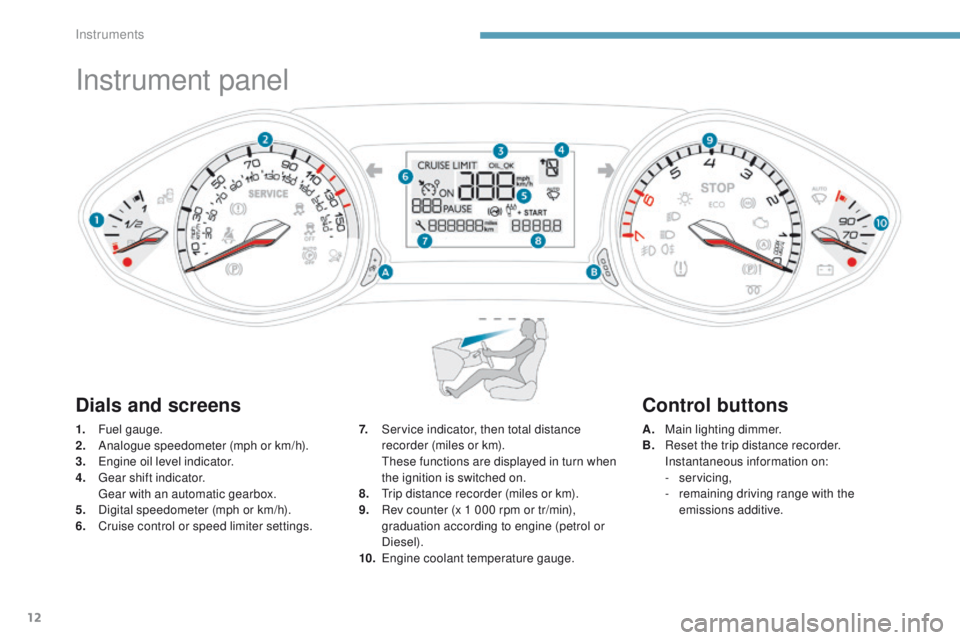
12
Instrument panel
1. Fuel gauge.
2. Analogue speedometer (mph or km/h).
3.
e
n
gine oil level indicator.
4.
g
e
ar shift indicator.
g
e
ar with an automatic gearbox.
5.
D
igital speedometer (mph or km/h).
6.
C
ruise control or speed limiter settings. A. M
ain lighting dimmer.
B. R eset the trip distance recorder.
I
nstantaneous information on:
-
servicing,
-
r
emaining driving range with the
emissions additive.
7. S
ervice indicator, then total distance
recorder (miles or km).
t
h
ese functions are displayed in turn when
the ignition is switched on.
8.
t
r
ip distance recorder (miles or km).
9.
R
ev counter (x 1 000 rpm or tr/min),
graduation according to engine (petrol or
Diesel).
10.
e
ng
ine coolant temperature gauge.
Dials and screens Control buttons
Instruments
Page 15 of 392
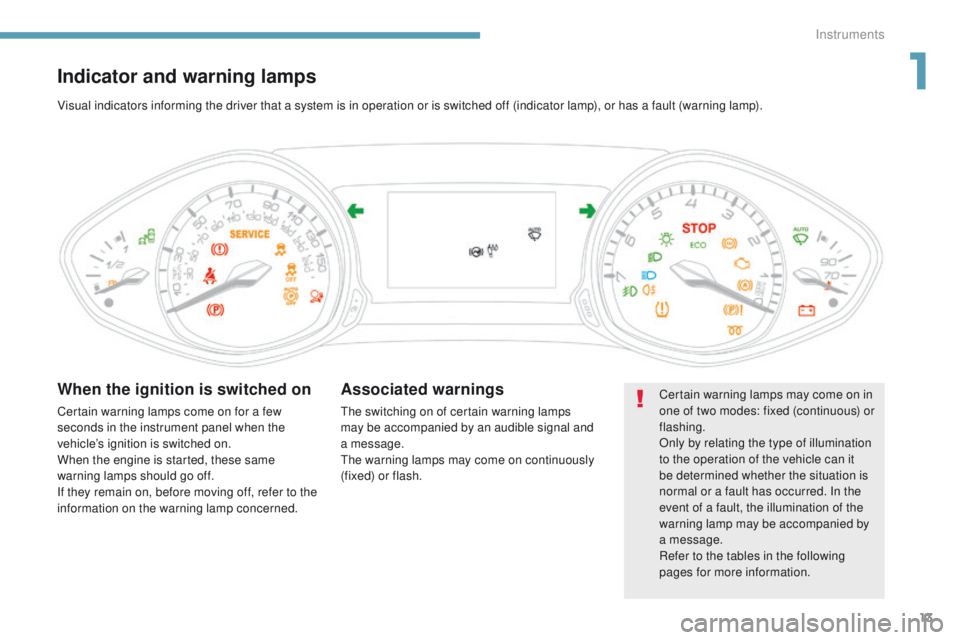
13
Indicator and warning lamps
Certain warning lamps may come on in
one of two modes: fixed (continuous) or
flashing.
Only by relating the type of illumination
to the operation of the vehicle can it
be determined whether the situation is
normal or a fault has occurred. In the
event of a fault, the illumination of the
warning lamp may be accompanied by
a message.
Refer to the tables in the following
pages for more information.
Visual indicators informing the driver that a system is in operation or is switched off (indicator lamp), or has a fault (warning lamp).When the ignition is switched on
Certain warning lamps come on for a few
seconds in the instrument panel when the
vehicle’s ignition is switched on.
When the engine is started, these same
warning lamps should go off.
If they remain on, before moving off, refer to the
information on the warning lamp concerned.
Associated warnings
the switching on of certain warning lamps
may be accompanied by an audible signal and
a
message.
th
e warning lamps may come on continuously
(fixed) or flash.
1
Instruments
Page 16 of 392
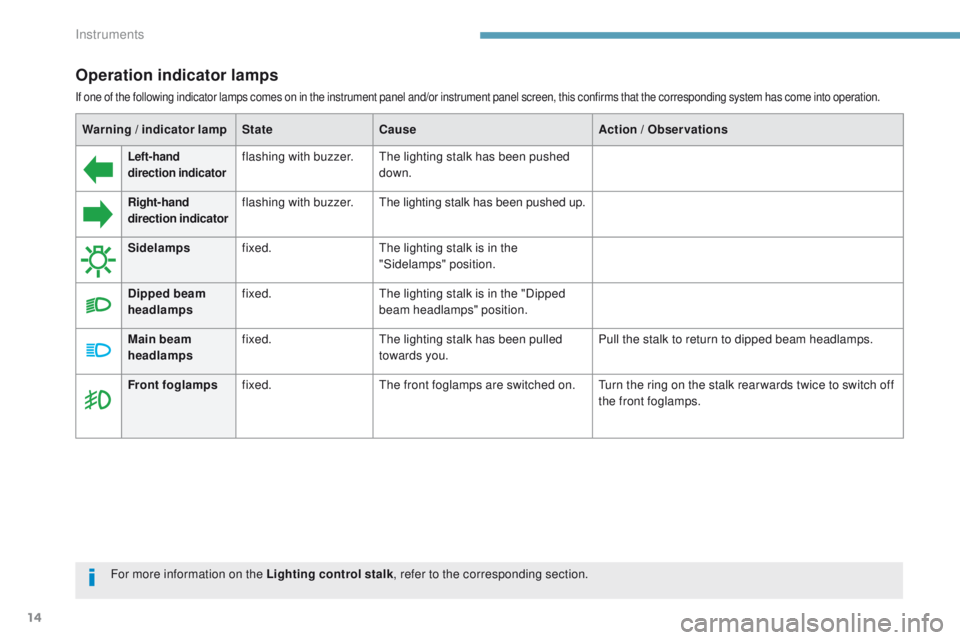
14
Operation indicator lamps
If one of the following indicator lamps comes on in the instrument panel and/or instrument panel screen, this confirms that the corresponding system has come into operation.
Warning / indicator lamp State Cause Action / Observations
Left-hand
direction indicatorflashing with buzzer.th e lighting stalk has been pushed
down.
Right-hand
direction indicatorflashing with buzzer.th e lighting stalk has been pushed up.
Sidelamps fixed.
th
e lighting stalk is in the
"Sidelamps" position.
Dipped beam
headlamps fixed.
th
e lighting stalk is in the "Dipped
beam headlamps" position.
Main beam
headlamps fixed.
th
e lighting stalk has been pulled
towards you. Pull the stalk to return to dipped beam headlamps.
Front foglamps fixed.
th
e front foglamps are switched on.
tu
rn the ring on the stalk rear wards twice to switch off
the front foglamps.
For more information on the Lighting control stalk , refer to the corresponding section.
Instruments
Page 27 of 392
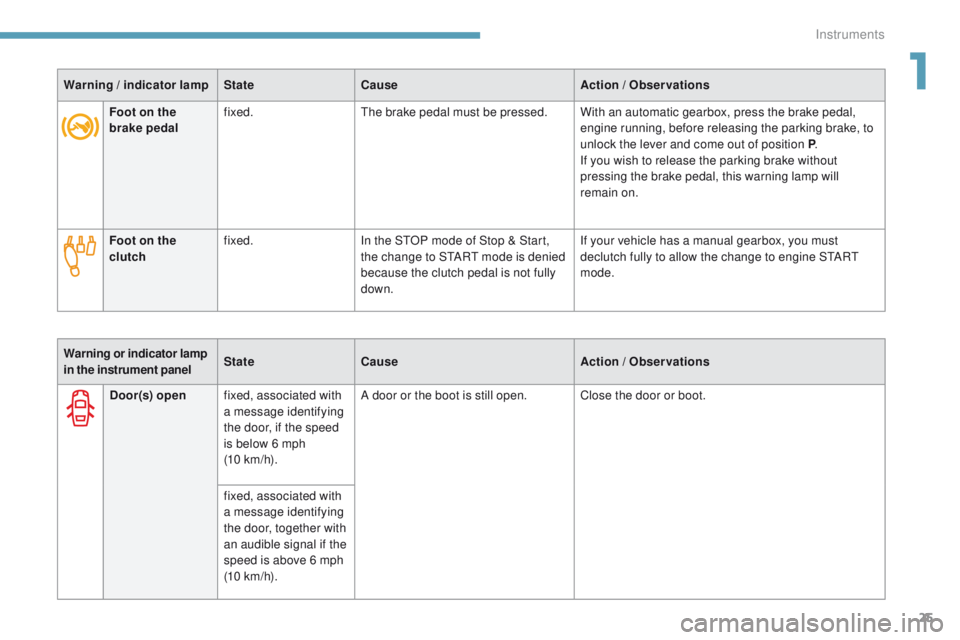
25
Foot on the
brake pedalfixed.th
e brake pedal must be pressed. With an automatic gearbox, press the brake pedal,
engine running, before releasing the parking brake, to
unlock the lever and come out of position P .
If you wish to release the parking brake without
pressing the brake pedal, this warning lamp will
remain on.
Foot on the
clutch fixed.
In the S
tO
P mode of Stop & Start,
the change to S
tA
R
t
mode is denied
because the clutch pedal is not fully
down. If your vehicle has a manual gearbox, you must
declutch fully to allow the change to engine S
tA
R
t
mode.
Warning
/ indicator lamp
State Cause Action
/ Observations
Door(s) open fixed, associated with
a message identifying
the door, if the speed
is below 6 mph
(10
km/h).A door or the boot is still open. Close the door or boot.
fixed, associated with
a message identifying
the door, together with
an audible signal if the
speed is above 6 mph
(10 km/h).
Warning or indicator lamp
in the instrument panel
State
Cause Action / Observations
1
Instruments
Page 28 of 392
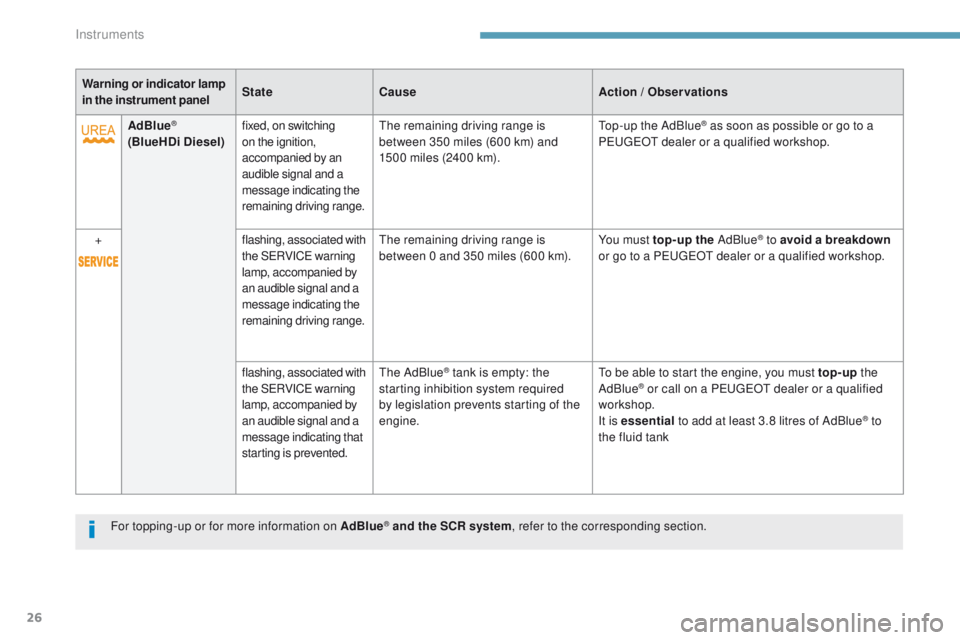
26
AdBlue®
(BlueHDi Diesel) fixed, on switching
on the ignition,
accompanied by an
audible signal and a
message indicating the
remaining driving range.the
remaining driving range is
between 350 miles (600 km) and
1500 miles (2400 km).to p-up the AdBlue® as soon as possible or go to a
Pe
ugeOt
dealer or a qualified workshop.
+ flashing, associated with
the S
eR
VIC
e
w
arning
lamp, accompanied by
an audible signal and a
message indicating the
remaining driving range.
the
remaining driving range is
between 0 and 350 miles (600 km). You must top-up the AdBlue
® to avoid a breakdown
or go to a Pe
ugeOt
dealer or a qualified workshop.
flashing, associated with
the S
eR
VIC
e
w
arning
lamp, accompanied by
an audible signal and a
message indicating that
starting is prevented.
th
e AdBlue
® tank is empty: the
starting inhibition system required
by legislation prevents starting of the
engine.to b e able to start the engine, you must top-up
the
AdBlue® or call on a Pe ugeOt dealer or a qualified
workshop.
It is essential to add at least 3.8 litres of AdBlue
® to
the fluid tank
Warning or indicator lamp
in the instrument panel
State
Cause Action / Observations
For topping-up or for more information on AdBlue
® and the SCR system , refer to the corresponding section.
Instruments
Page 29 of 392
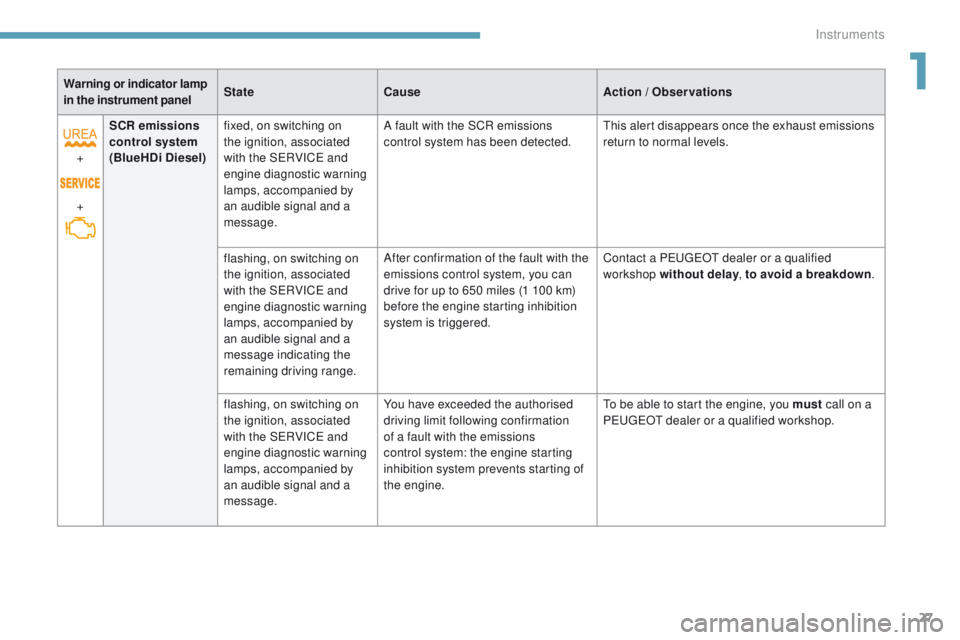
27
Warning or indicator lamp
in the instrument panelState
Cause Action / Observations
+
+ SCR emissions
control system
(BlueHDi Diesel) fixed, on switching on
the ignition, associated
with the S
eR
VIC
e
and
engine diagnostic warning
lamps, accompanied by
an audible signal and a
message. A fault with the SCR emissions
control system has been detected.
th
is alert disappears once the exhaust emissions
return to normal levels.
flashing, on switching on
the ignition, associated
with the S
eR
VIC
e
and
engine diagnostic warning
lamps, accompanied by
an audible signal and a
message indicating the
remaining driving range. After confirmation of the fault with the
emissions control system, you can
drive for up to 650 miles (1 100 km)
before the engine starting inhibition
system is triggered.
Contact a P
e
uge
Ot
dealer or a qualified
workshop without delay , to avoid a breakdown.
flashing, on switching on
the ignition, associated
with the S
eR
VIC
e
and
engine diagnostic warning
lamps, accompanied by
an audible signal and a
message. You have exceeded the authorised
driving limit following confirmation
of a fault with the emissions
control system: the engine starting
inhibition system prevents starting of
the
engine.
to b
e able to start the engine, you must call on a
P
e
uge
Ot
dealer or a qualified workshop.
1
Instruments
Page 33 of 392
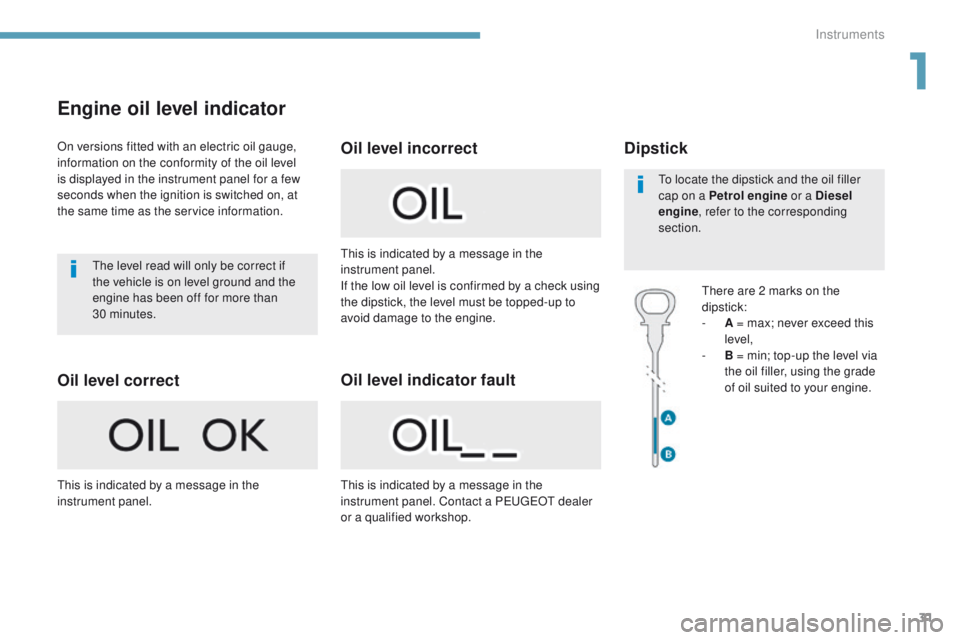
31
Engine oil level indicator
On versions fitted with an electric oil gauge,
information on the conformity of the oil level
is displayed in the instrument panel for a few
seconds when the ignition is switched on, at
the same time as the service information.
th
e level read will only be correct if
the vehicle is on level ground and the
engine has been off for more than
30
minutes.
th
is is indicated by a message in the
instrument panel.
th
is is indicated by a message in the
instrument panel.
If the low oil level is confirmed by a check using
the dipstick, the level must be topped-up to
avoid damage to the engine.
th
is is indicated by a message in the
instrument panel. Contact a P
e
uge
Ot
dealer
or a qualified workshop.Dipstick
there are 2 marks on the
dipstick:
-
A
= max; never exceed this
level,
-
B
= min; top-up the level via
the oil filler, using the grade
of oil suited to your engine.
to l
ocate the dipstick and the oil filler
cap on a Petrol engine or a Diesel
engine , refer to the corresponding
section.
Oil level correct Oil level indicator fault Oil level incorrect
1
Instruments